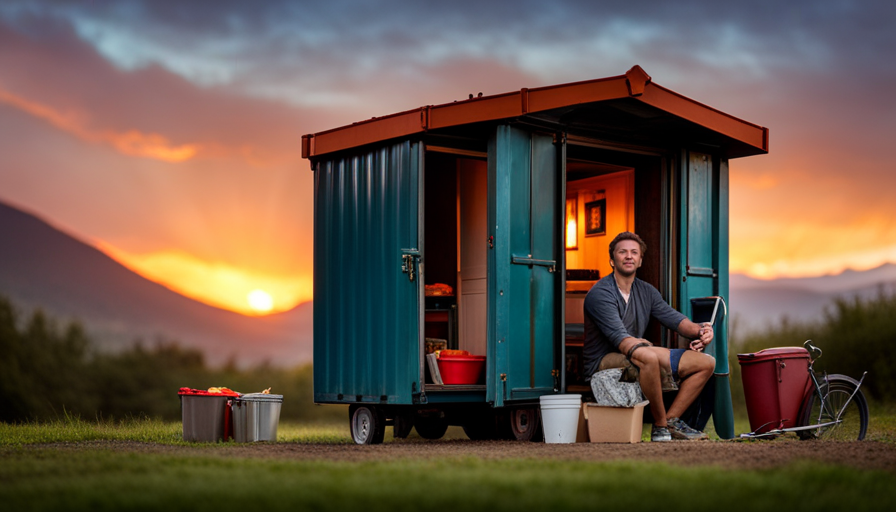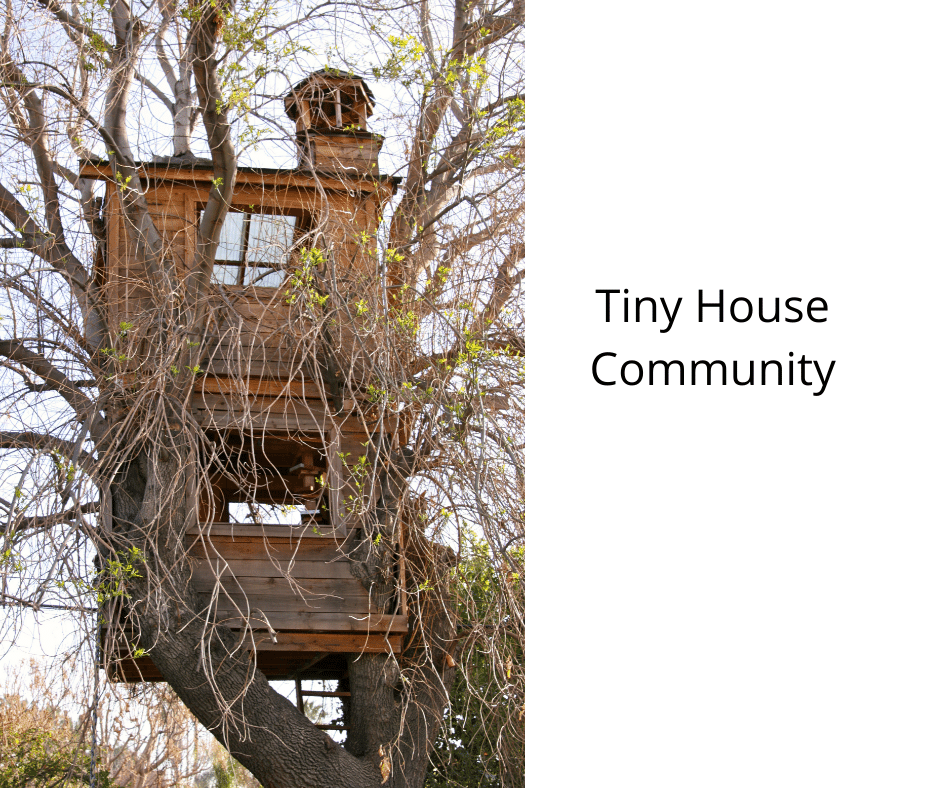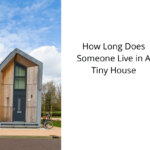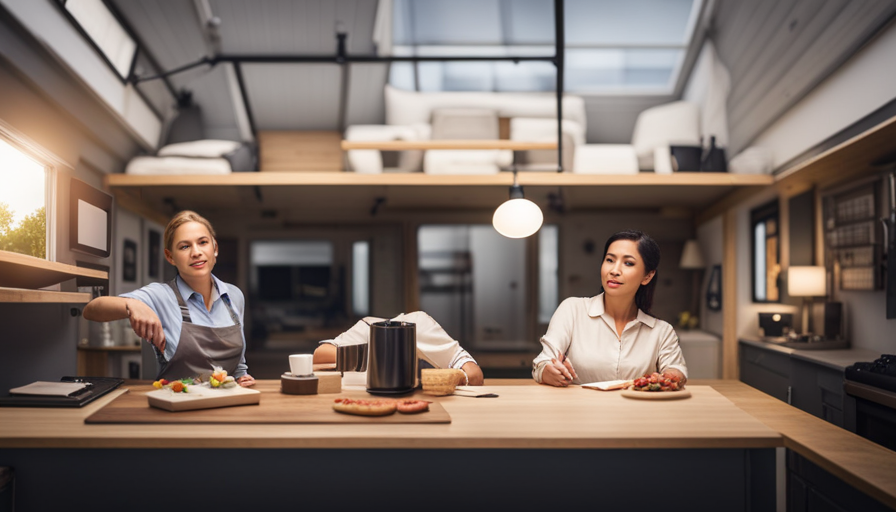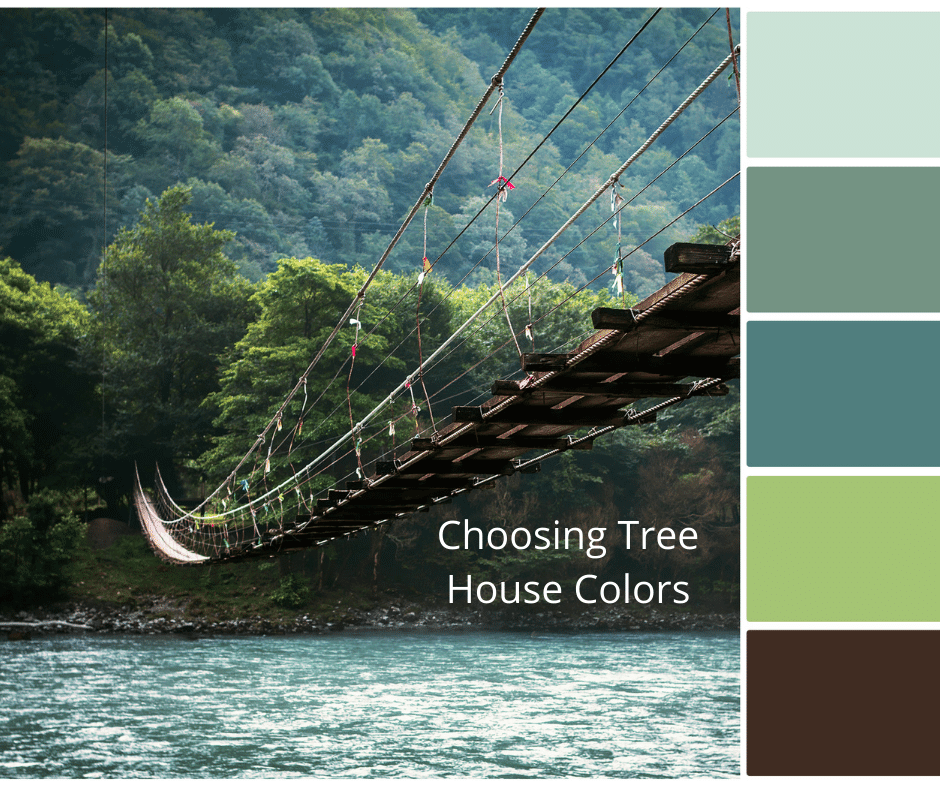Did you know that in the United States, there are over 500,000 people living without homes? It’s a staggering statistic that often goes unnoticed.
But today, I want to share with you the remarkable story of a man who not only overcame homelessness but also turned his life around in the most unexpected way. Meet John, the guy who lived in a dumpster and made a tiny house.
John’s journey began when he found himself living on the streets, with no place to call home. Determined to change his circumstances, he stumbled upon an idea that would not only provide him with shelter but also give him a renewed sense of purpose. He decided to build a tiny house out of a dumpster.
In this article, we’ll explore the inspiration behind John’s project, the challenges he faced along the way, and the lessons he learned from living in his unique creation.
Join me as we delve into the world of dumpster living and discover the impact and legacy that John has left behind.
Key Takeaways
- John’s transformation of a dumpster into a cozy tiny house showcases remarkable creativity and resourcefulness.
- His unconventional living space challenges societal norms and encourages rethinking traditional housing.
- John’s lifestyle inspires simplicity, minimalism, and prioritizing experiences and connections over material possessions.
- The impact and legacy of John’s tiny house have sparked a movement towards more sustainable and minimalist living.
The Inspiration Behind the Project
Imagine living in a dumpster, feeling the daily struggle of finding shelter, until one day, I stumbled upon the idea to create a tiny house out of it. Overcoming obstacles became a way of life for me, and finding inspiration in the most unlikely places became my mission.
As I looked at the dumpster, I saw potential, a blank canvas waiting to be transformed. It was a daunting task, but I was determined to turn it into a cozy home. I started by cleaning it out, removing the trash and debris that had accumulated over time. Slowly, I began to build walls, install windows, and create a space that was not only functional but also aesthetically pleasing.
It was a labor of love, fueled by my desire to escape the harsh realities of homelessness. With each step, I grew more motivated, and eventually, I found the perfect dumpster to transform into my humble abode.
Finding the Perfect Dumpster
In his quest for the ideal dumpster, I scoured the urban landscape, seeking refuge in the most inconspicuous of shelters. Repurposing materials became my mission, as I aimed to create a sustainable housing solution.
The first dumpster I stumbled upon was a treasure trove of discarded wood planks, perfect for building the foundation of my tiny house.
Next, I discovered a dumpster filled with discarded windows, which would allow natural light to flood my new abode.
Lastly, I found a dumpster overflowing with discarded furniture, providing me with the essentials for my humble living space.
With these repurposed materials, I set out to design my dream tiny house, a testament to sustainable living. Incorporating these salvaged items into my design allowed me to create a unique and environmentally-friendly home.
Moving from dumpster to design, I began the next chapter of my extraordinary journey.
Designing the Tiny House
Create the blueprint for your one-of-a-kind sustainable dwelling, carefully considering every detail of your future compact home.
When designing your tiny house, there are several design considerations to keep in mind. First, think about how to optimize the space. Maximizing storage is essential in such a small living area, so consider incorporating hidden compartments and multi-purpose furniture.
Additionally, think about the layout and flow of the space to ensure it feels open and functional. Don’t forget to consider natural light and ventilation when choosing window placements.
Lastly, choose materials that are both durable and eco-friendly to minimize your environmental impact.
Now that the design considerations have been addressed, it’s time to overcome the challenges that come with building a tiny house.
Overcoming Challenges
To overcome the challenges of building your sustainable dwelling, you’ll need to roll up your sleeves and embrace the adage ‘where there’s a will, there’s a way.’
Building a tiny house from a dumpster certainly presented its fair share of obstacles, but with determination and a bit of creativity, I was able to overcome them all.
One of the biggest challenges was figuring out how to maximize the limited space while still maintaining functionality. I had to think outside the box and come up with innovative storage solutions and multi-purpose furniture.
Additionally, I had to learn new skills like plumbing and electrical work to ensure the house was fully functional. In the process, I built resilience and developed problem-solving abilities that have proven invaluable.
Now, let’s delve into the next chapter of this incredible journey – living in the dumpster house.
Living in the Dumpster House
Living in this unconventional home brought a unique sense of fulfillment and contentment. It was a sustainable lifestyle that allowed me to embrace simplicity and reduce my carbon footprint. Here are five things that made living in the Dumpster House so special:
-
Minimalism: Living in a tiny space forced me to prioritize what truly mattered and let go of unnecessary possessions.
-
Connection with nature: The small size of the house encouraged me to spend more time outdoors, connecting with the environment and appreciating its beauty.
-
Community: Living in such a unique home sparked curiosity and conversations with neighbors, creating a strong sense of camaraderie.
-
Creativity: Designing and organizing the limited space challenged me to think creatively and find innovative solutions.
-
Freedom: Embracing unconventional living allowed me to break free from societal norms and embrace a lifestyle that aligned with my values.
Living in the Dumpster House taught me invaluable lessons about sustainability, resilience, and the power of simplicity.
Lessons Learned
When living in the Dumpster House, I learned valuable lessons about creativity and resourcefulness.
I had to think outside the box and find innovative solutions to everyday problems.
It was a constant exercise in finding new ways to repurpose and maximize every available resource.
This experience redefined my understanding of what it means to have a home.
I learned that home is about creating a comfortable and functional space that reflects one’s personality and values.
Creativity and Resourcefulness
Imagine the incredible ingenuity it takes to transform a dumpster into a cozy and functional tiny house. This guy’s creativity and resourcefulness are truly remarkable.
By utilizing innovative solutions and optimizing every available resource, he was able to create a living space that defied expectations. From using salvaged materials for insulation to repurposing old furniture for storage, he found ways to make the most out of limited resources.
It’s inspiring to see how he turned something discarded and overlooked into a place that redefines the meaning of home. This demonstrates that with a little creativity and resourcefulness, even the most unconventional spaces can be transformed into something beautiful and meaningful.
Redefining the Meaning of Home
You can’t help but feel a sense of awe and wonder as you witness the transformation of a forgotten space into a place that redefines what it means to call somewhere home. Rethinking traditional housing and embracing unconventional living spaces, this guy who lived in a dumpster has truly challenged societal norms.
He proves that a home can be created from unexpected materials.nnHe inspires us to question the necessity of large, traditional houses.nnHe demonstrates that simplicity and minimalism can lead to a fulfilling lifestyle.nnHe encourages us to prioritize experiences and connections over material possessions.
This guy’s innovative approach to redefining the meaning of home has left a lasting impact and created a legacy that continues to inspire others. As we delve into the next section about his impact and legacy, we can truly appreciate the significance of his unconventional living space.
The Impact and Legacy
The impact and legacy of the guy who lived in a dumpster and made a tiny house are significant in inspiring others to think outside the box and promoting sustainable living.
His unique lifestyle and innovative solution to housing challenges have captured the attention and imagination of people around the world.
By showing that it’s possible to live comfortably in a small space while minimizing environmental impact, he has sparked a movement towards more sustainable and minimalist living.
Inspiring Others to Think Outside the Box
Get inspired by this guy who lived in a dumpster, creating a tiny house and showing others how to think outside the box. His unique approach to living creatively and breaking barriers has inspired countless individuals to reimagine what is possible.
Here are three key takeaways from his journey:
-
Embrace unconventional solutions: He proved that it’s possible to turn something as ordinary as a dumpster into a comfortable and sustainable living space. This challenges us to think outside the box and find innovative solutions to everyday problems.
-
Rethink our priorities: His story encourages us to question societal norms and reassess our own values. By living with less and focusing on what truly matters, we can shift our mindset towards a more fulfilling and sustainable lifestyle.
-
Empowerment through example: By sharing his experience and knowledge, he empowers others to take control of their own lives and make positive changes. His story serves as a reminder that we all have the power to create a meaningful impact.
By promoting sustainable living, we can build upon the foundation he has laid and continue to make a difference in our world.
Promoting Sustainable Living
Embracing unconventional solutions and rethinking our priorities, we can create a sustainable lifestyle inspired by the man who turned a simple dumpster into a comfortable and innovative home. Sustainable housing options and eco-friendly lifestyle choices are key to promoting a greener future. By adopting sustainable housing options, such as tiny houses or repurposed containers, we can reduce our ecological footprint and minimize resource consumption. These alternative housing solutions often incorporate renewable energy sources and efficient insulation, making them environmentally friendly and cost-effective.
To further promote sustainable living, we can make eco-friendly lifestyle choices, such as reducing waste, conserving energy, and choosing sustainable materials. Recycling and upcycling are great ways to minimize waste and extend the lifespan of products. Additionally, using energy-efficient appliances, opting for public transportation or biking, and supporting local and organic food sources all contribute to a more sustainable lifestyle.
By embracing these sustainable housing options and eco-friendly lifestyle choices, we can not only reduce our impact on the environment but also inspire others to make positive changes. Together, we can create a more sustainable future for generations to come.
| Sustainable Housing Options | Eco-Friendly Lifestyle Choices | Innovative Solutions | ||||
|---|---|---|---|---|---|---|
| Tiny houses | Recycling | Renewable energy | ||||
| Repurposed containers | Upcycling | Energy efficiency | ||||
| Green building materials | Public transportation | Local and organic food | Eco-friendly products | Sustainable living | Water conservation |
Frequently Asked Questions
How did the guy come up with the idea of living in a dumpster and building a tiny house?
Living in a dumpster and building a tiny house was inspired by a desire for simplicity and sustainability. The idea struck me when I realized the amount of waste we produce and the potential to repurpose discarded materials.
Dumpster living allowed me to minimize my environmental impact and live a more sustainable lifestyle. It challenged societal norms and encouraged others to think creatively about sustainable living practices.
What were the main factors the guy considered when choosing the dumpster for his project?
When choosing the dumpster for my project, I carefully considered several factors. Firstly, I needed a dumpster that was in good condition and structurally sound.
I also looked for a dumpster that was large enough to accommodate my needs but not too big to be overwhelming.
Additionally, I considered the location of the dumpster, ensuring it was in a safe and accessible area.
These considerations were vital in creating my unique tiny house.
What were the key design elements and considerations that went into creating the tiny house from a dumpster?
Key design elements and considerations that went into creating the tiny house from a dumpster included maximizing space efficiency, ensuring structural integrity, and incorporating essential amenities.
I carefully planned the layout to optimize storage and functionality, utilizing every inch of available space.
Safety was a top priority, so I reinforced the dumpster walls and added proper insulation.
Additionally, I incorporated sustainable features like solar panels to minimize my environmental impact.
The Dumpster transformation became my innovative solution for comfortable and eco-friendly Dumpster living.
What were some of the most significant challenges the guy faced during the construction process and how did he overcome them?
During the construction process, I faced some significant challenges that required creative problem-solving. One particular hurdle was finding suitable materials to transform the dumpster into a tiny house. It was like searching for a needle in a haystack, but I overcame this obstacle by repurposing salvaged items and using innovative techniques.
Additionally, the limited space presented a challenge, but I cleverly utilized every nook and cranny to maximize functionality. Overcoming these construction challenges made the end result even more rewarding.
Can you provide some insights into the daily life and experiences of living in the dumpster house, including the pros and cons?
Living in the dumpster house had its challenges, but it also had some unexpected benefits. Daily routines required careful organization of limited space, but it forced me to simplify my life and be resourceful. Adapting to a small space was initially tough, but I learned to prioritize what I truly needed.
The pros of living in the dumpster house included reduced expenses and a sense of freedom. It was a cost-effective way to live, and I didn’t have to worry about paying rent or a mortgage. I also felt a sense of freedom because I wasn’t tied down to a specific location or belongings.
However, there were also cons to living in the dumpster house. One major drawback was the lack of privacy. Since the space was so small, it was difficult to have any personal space or alone time. I also had to constantly be mindful of my surroundings because I was living in a public area. I had to be cautious about who was around and make sure I was safe.
Overall, living in the dumpster house had its ups and downs. It required a lot of adjustment and resourcefulness, but it also provided a unique and cost-effective living experience.
Conclusion
Living in the dumpster house has truly been a transformative experience. From the depths of despair, I’ve risen like a phoenix, creating a tiny oasis amidst the chaos.
This project has taught me resilience, resourcefulness, and the ability to find beauty in the most unexpected places.
As I reflect on the impact and legacy of my journey, I’m filled with a sense of awe and gratitude. May my story inspire others to find hope in even the darkest corners of their lives.
Hi, I’m Emma. I’m the Editor in Chief of Tiny House 43, a blog all about tiny houses. While tree houses are often associated with childhood, they can be the perfect adult retreat. They offer a cozy space to relax and unwind, surrounded by nature. And since they’re typically built on stilts or raised platforms, they offer stunning views that traditional homes simply can’t match. If you’re looking for a unique and romantic getaway, a tree house tiny house might just be the perfect option.
